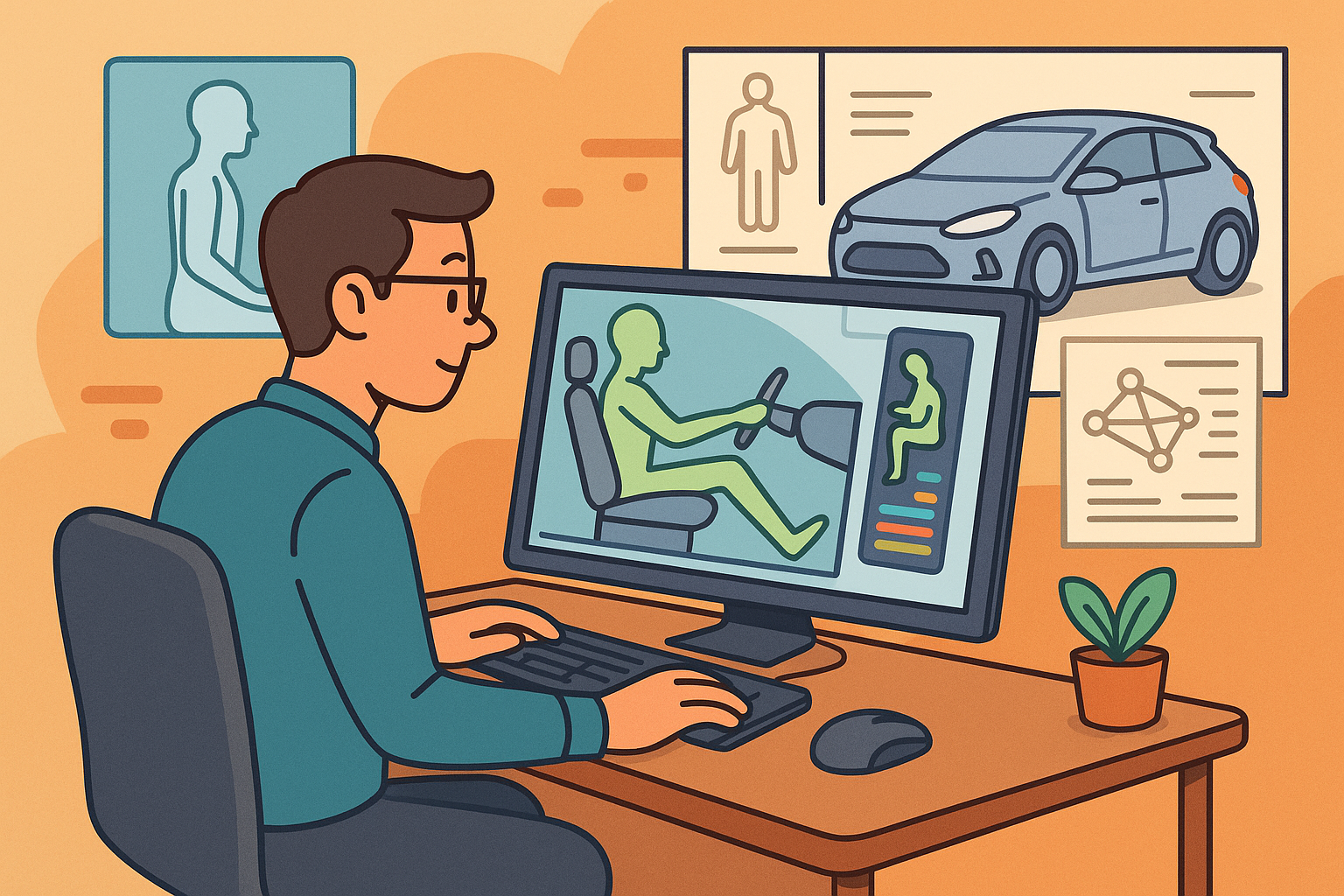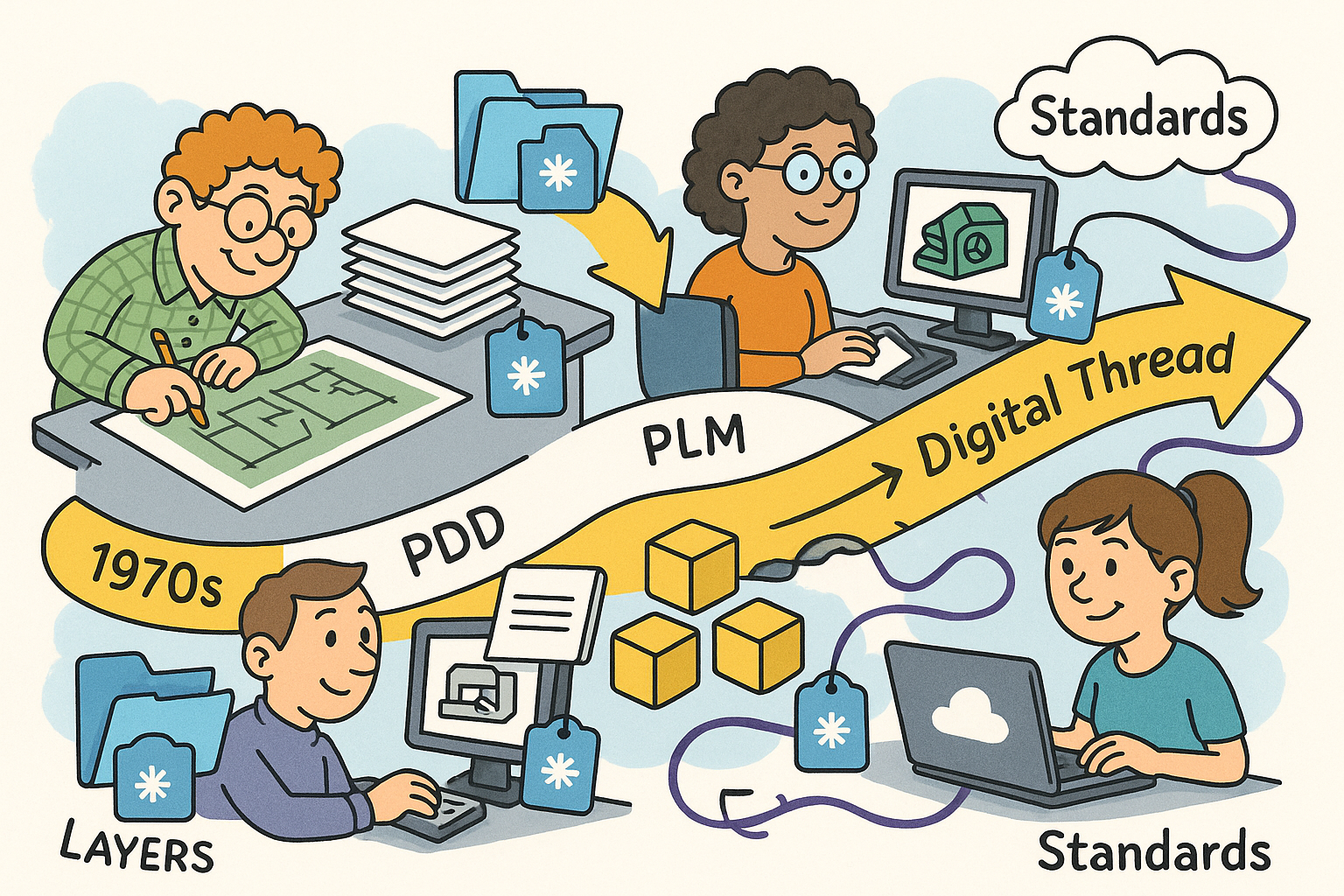Your Cart is Empty
Customer Testimonials
-
"Great customer service. The folks at Novedge were super helpful in navigating a somewhat complicated order including software upgrades and serial numbers in various stages of inactivity. They were friendly and helpful throughout the process.."
Ruben Ruckmark
"Quick & very helpful. We have been using Novedge for years and are very happy with their quick service when we need to make a purchase and excellent support resolving any issues."
Will Woodson
"Scott is the best. He reminds me about subscriptions dates, guides me in the correct direction for updates. He always responds promptly to me. He is literally the reason I continue to work with Novedge and will do so in the future."
Edward Mchugh
"Calvin Lok is “the man”. After my purchase of Sketchup 2021, he called me and provided step-by-step instructions to ease me through difficulties I was having with the setup of my new software."
Mike Borzage
Shift-Left Ergonomics: Integrating Digital Human Modeling into Concept Design
November 10, 2025 10 min read


Why bring digital humans into concept design
Shift-left ergonomics as a design accelerator
Design programs succeed or slip based on how early they surface human factors constraints and turn them into actionable geometry. Bringing digital human modeling (DHM) into the concept phase enables a deliberate shift-left of ergonomics, aligning human capabilities with form, interface, and manufacturing while change is still cheap. When human reach, clearance, and strength margins are modeled alongside mass and packaging from the first sketches, teams avoid the late-stage geometry churn that comes from discovering an operator cannot see a critical indicator, reach a fastener at the required torque, or service a component without removing an entire assembly. This shift-left ergonomics posture prevents tool rework, reduces safety retrofits, and streamlines certification because anthropometric diversity and task demands are embedded in the earliest design envelopes, rather than bolted on after DV/PV tests. It also builds organizational muscle for evidence-based trade-offs: engineering can demonstrate, with quantifiable posture and load predictions, why a handle must move 40 mm upward or a service door must open to 110° rather than 90°. The value is cumulative; each early iteration captures insight about human interaction that composes into robust geometry and station design.
- Eliminate late surprises: discover unworkable reaches, pinch hazards, and occluded sight lines before tooling release.
- Reduce rework: bake access and service envelopes into CAD so fixtures and harnesses do not have to be re-engineered.
- Accelerate compliance: align to safety and accessibility thresholds from day one to avoid costly retrofits.
- Enable clearer justification: tie geometry moves to quantified comfort and risk deltas, not opinion.
Early checks shape envelope-defining decisions
At concept fidelity, engineers define volumes, mechanisms, and controls that will harden into constraints for years. Deploying DHM here means those decisions are guided by fast checks on reach, clearances, sight lines, control placement, and service access. A handful of carefully chosen avatar postures run through inverse kinematics can reveal whether a 5th percentile user can reach the emergency stop without trunk flexion, whether a helmeted head clears the frame at full seat travel, and whether an inspector can read a critical label at specified luminance and contrast. These early checks become guardrails that shape the outer envelope, ensuring floor panels, harness routings, and hinge arcs do not inadvertently eliminate feasible human configurations. Just as importantly, they expose hidden coupling between subsystems and human posture: how fastener orientation dictates tool approach and wrist deviation, why a packaging rib blocks a harness bend radius that in turn escalates assembly force, or how a cable bundle’s slack removes the only safe tool vector.
- Envelope guidance: define reach cones, visibility cones, and approach vectors as persistent CAD references.
- Clearance assurance: capture head/helmet, glove, and knee clearances through dynamic reach sweeps, not single snapshots.
- Serviceability by design: simulate removal sequences to preserve minimum service windows and hand/tool envelopes.
- Prevent hidden coupling: identify where packaging, wiring, and fastener orientation entangle with human posture and access.
Make outcomes measurable and inclusive
Early ergonomics is most persuasive where it is measurable. Teams should set quantitative targets that translate directly into design accept/reject criteria and build them into dashboards that travel with the CAD. Typical outcomes include coverage, risk, load margins, time/cycle, and inclusivity. For coverage, mandate that critical features are reachable by 5th–95th percentile users without exceeding posture thresholds. For risk, require RULA/REBA scores within acceptable bands and a NIOSH Lifting Index ≤ 1 for specified handling tasks. For loads, compute joint torques and compare to strength models to maintain at least a 20% reserve for the target population. For time, ensure assembly and service tasks fit within takt and service-level objectives under modeled fatigue. For inclusivity, document accessibility conformance (e.g., ADA, ISO 9241) and verify multi-modal interaction scenarios, including wheelchair users and operators wearing PPE or exoskeletons. When these targets are first-class citizens in the design reviews, they prevent ambiguous debates and reinforce a design culture where human-centered performance is a non-negotiable constraint, not a late-stage optimization.
- Coverage: 5th–95th percentile reach to all critical features with allowable joint angles.
- Risk: RULA/REBA in green/yellow bands; NIOSH Lifting Index ≤ 1 for defined lifts.
- Load margins: predicted torques with ≥20% strength reserve across key joints.
- Time/cycle: task times fit takt; service tasks meet service-level goals under fatigue.
- Inclusivity: accessibility conformance and verification of multi-modal use scenarios.
What modern DHM and ergonomic simulation can do
Anthropometry and variability beyond simple percentiles
Modern DHM tools model bodies as correlated systems, not isolated percentiles. Instead of treating stature, arm length, and shoulder breadth as independent dials, they draw on population studies—CAESAR, DINED, NHANES—to generate avatars whose dimensions obey realistic covariances. This matters: a “95th percentile arm length” paired with a “5th percentile torso” may never occur in the target population, and designing around that chimera wastes space or misses true worst cases. Population filtering further refines realism: regional populations, occupation-specific cohorts, wheelchair users, and individuals wearing PPE (gloves, respirators, face shields, exoskeletons) can be instantiated with appropriate dimension offsets and range-of-motion adjustments. Uncertainty-aware sampling then explores the tails to discover where risk accumulates. By running Monte Carlo draws over the correlated space, teams find the hard-to-spot users for whom a particular hinge or console height is unsafe, and quantify how confident they are that a constraint holds at the 90th or 95th percentile. The result is a portfolio of avatars that meaningfully represents who will build, use, or service the product, rather than a token “5th, 50th, 95th” set that masks true variability.
- Correlated bodies: parametric avatars spanning realistic combinations of body dimensions.
- Population specificity: region, occupation, and equipment filters including PPE and mobility aids.
- Uncertainty awareness: Monte Carlo sampling under covariance to locate worst-case users.
- Actionable outputs: percentile-satisfied constraints with confidence intervals, not just point predictions.
Posture, task, and load modeling with standards
The predictive core of DHM is how it computes posture and load under task demands. Contemporary engines solve inverse kinematics with joint limits and soft comfort costs to reach targets with minimal deviation, then apply inverse dynamics to derive joint moments under external loads, gravity, and tool forces. Static analyses (e.g., 3DSSPP) estimate spine compression and joint torques for posture snapshots, while time-varying models combine MET curves and endurance time to predict fatigue accumulation over a shift. These outputs feed standards-based scoring—RULA, REBA, OCRA, ISO 11228, ISO 11226—that contextualize all results in familiar color bands for HSE teams. Beyond lifting, leading tools model push/pull, NIOSH calculations, torque tool use including trigger forces and reaction torque, and fine-motor tasks that depend on pinch force and visual acuity. This closes the loop between posture feasibility and risk, connecting geometry to quantified comfort and capacity. Critically, these models can be scripted into task sequences so engineers can evaluate entire assemblies or service procedures as time-resolved simulations rather than isolated snapshots, enabling takt and fatigue to be analyzed simultaneously.
- IK/ID with comfort costs: posture solutions respect joint limits and minimize strain.
- Load and fatigue: static/dynamic models compute torques, compression, and endurance.
- Standards alignment: RULA, REBA, OCRA, ISO 11228/11226 scoring for clear governance.
- Diverse task types: lifting/carrying, push/pull, power and torque tools, fine-motor operations.
Perception fields and immersive, sensor-integrated workflows
Human interaction extends beyond reach and load; perception defines functionality. DHM can project line of sight, field of view, and glare analyses to ensure displays are legible at expected distances and angles, incorporating luminance, contrast, and font size rules. Control operability zones help position knobs and switches within comfortable reach without imposing awkward wrist deviations, while head and helmet clearances prevent impacts during ingress/egress and within tight cabins. Pinch/no-go zones are generated to minimize injury risk, and service envelope volumes formalize safe tool approach vectors. To bridge simulation and human intuition, teams increasingly run VR/AR evaluations with motion capture, letting operators attempt virtual builds while the system logs joint angles, occlusions, and collisions in real time. Collisions and line-of-sight occlusions are flagged immediately, and heatmaps summarize where risky postures occur across variants and stations. PPE and exoskeleton effects can be toggled to see how range of motion and strength change with gear. The blend of perception modeling and immersive validation exposes mismatches between planned geometry and actual human movement early enough to fix them without disrupting downstream tooling schedules.
- Perception modeling: reach, line of sight, field of view, glare, and legibility constraints.
- Safety zones: head/helmet clearances, pinch/no-go volumes, and service envelopes.
- Immersive validation: VR/AR with motion capture and real-time collision/occlusion feedback.
- Analytics: posture risk heatmaps over product variants and stations to focus improvement.
Implementation patterns inside design software
Parametric coupling and continuous checks in the model
The most effective DHM programs wire human constraints directly into CAD so that geometric intent and ergonomics co-evolve. Parametric coupling allows engineers to drive manikin postures from CAD constraints—seat track position, pedal travel, handle angles—and, in turn, drive CAD features from ergonomic results—moving a control until reach costs minimize or rotating a panel until wrist deviation falls under thresholds. DHM configurations and task scripts should live as versioned features in the model tree for traceability, just like mates and sketches. Surrounding this linkage is a scaffolding of automated checks: Design for Ergonomics (DFE)
- Two-way coupling: drive manikins from CAD and drive CAD from ergonomic constraints.
- Traceable DHM: store avatars, postures, and task scripts as first-class model features.
- Automated DFE: reach, clearance, strength, fastener access, and two-hand rules run on change.
- PDM/PLM integration: Monte Carlo checks on revision; regressions flagged with rich context.
Optimization, trade studies, and robust design
Because ergonomics competes with packaging, cost, and aesthetics, optimization is the natural language for trade-offs. Multi-objective solvers can balance comfort (minimize RULA/REBA scores), cycle time (minimize task duration under fatigue models), packaging (respect volume and interference constraints), and cost (minimize part count or complexity). Variables span handle positions and diameters, control sizes and stiffness, panel hinge axes, seat tracks, service window locations, and workstation heights. The key is to phrase constraints robustly: rather than optimizing for a single 50th percentile user, require that 90% or 95% of a population meets reach and strength thresholds with specified confidence. Uncertainty-aware Monte Carlo then evaluates candidate designs across sampled avatars and noise in task loads, surfacing trade surfaces where minor geometry changes unlock large risk reductions. Visual decision artifacts—Pareto fronts annotated with percentile satisfaction—help cross-functional teams converge on viable compromises. Optimization scripts belong in the same repository as CAD and DHM artifacts, enabling repeatable studies as the design evolves and ensuring that when geometry shifts, the solver is rerun and its recommendations remain current.
- Objectives: minimize risk scores and cycle time; maximize coverage; respect mass/volume constraints.
- Variables: handles, controls, hinges, seat tracks, workstation heights, service windows.
- Robust constraints: percentile-satisfied reach/strength with confidence intervals.
- Decision support: Pareto fronts and sensitivity maps to explain trade-offs transparently.
Manufacturing, service integration, and governance
Ergonomics extends from product to process, so integrating DHM with manufacturing and service pays dividends across the lifecycle. For assembly lines, simulations inform station heights, part presentation angles, tool tethers, and lift assists, ensuring that takt targets are achievable without accumulating fatigue hot spots. Tool approach vectors and reaction torque management are evaluated to prevent high-risk wrist deviation and to specify necessary torque arms. For maintainability, sequence simulations validate that removal/installation tasks respect minimum service clearances and that fasteners are oriented for standard tool access. These checks flow into routing, fixture, and kitting strategies. Governance binds it all: anthropometric assumptions, PPE sets, and task scripts are versioned and attached to part revisions, ensuring every decision can be traced to the population and method behind it. Bias and inclusivity checks verify that representative users—including wheelchair users and small-stature operators—are in scope. Correlation with pilot studies, time-motion data, and sensor logs closes the model-reality gap; when discrepancies exceed thresholds, model parameters are updated and back-propagated to affected decisions. This loop creates an auditable chain that supports safety sign-off, accessibility conformance, and sustainable workforce design.
- Line design: station heights, part presentation, tool tethers, lift assists, and fatigue management.
- Serviceability: tool approach vectors, fastener orientation, and minimum service clearances.
- Governance: version anthropometry, tasks, and PPE; attach to part/bom revisions.
- Validation: correlate with pilot/time-motion data; update models when thresholds are exceeded.
Conclusion
Elevate digital humans to first-class design entities
When human performance is treated as a first-class design entity from concept onward, teams make earlier, cheaper, and more inclusive decisions. The geometry that emerges is not only more buildable and serviceable; it is also safer and accessible to a broader population, reflecting real-world anthropometry rather than idealized averages. Embedding digital humans alongside loads, clearances, and materials turns ergonomics into an engineering discipline with the same rigor as structural analysis. Instead of discovering at PPAP that a subassembly forces high wrist deviation or that an inspection port is unreadable from a wheelchair, those issues are resolved while the cost of change is still measured in millimeters and minutes. The ultimate benefit is portfolio-level resilience: products arrive with fewer last-minute packaging changes, stations launch with fewer recordables, and service teams achieve faster turnaround because parts were designed with human access, force limits, and perception in mind. Treating DHM as foundational does not slow innovation; it accelerates it by removing avoidable friction and surfacing trade-offs when they are most negotiable.
- Earlier: decisions on reach, sight, and access are made before hardware hardens.
- Cheaper: fewer tool reworks and safety retrofits reduce capital churn.
- More inclusive: broader user coverage and accessibility by design.
A practical recipe teams can adopt incrementally
Adopting DHM need not be monolithic. A pragmatic path begins with a narrow but high-impact gate and scales as confidence grows. Start by tethering automated reach and RULA checks to CAD revisions—every save triggers a quick analysis on a small, representative avatar set. As this becomes routine, expand anthropometry to correlated populations and introduce uncertainty-aware sampling so constraints are percentile-satisfied. Next, script key tasks—assembly of a tight submodule, a recurring maintenance operation—and include time/fatigue models to align with takt or service goals. From there, add perceptual fields (line of sight, legibility) and run immersive VR/AR sessions to validate posture predictions and uncover occlusions. Parallel to capability growth, establish governance: version anthropometry and tasks, bind them to part revisions, and define bias checks. Finally, introduce multi-objective optimization to formalize trade-offs and standardize decision artifacts. The aim is not tools for their own sake, but a durable workflow where human-centered performance becomes a non-negotiable design constraint that is enforced as automatically as interference checks or mass properties.
- Step 1: automated reach and RULA gates tied to CAD saves.
- Step 2: correlated anthropometry and uncertainty-aware Monte Carlo for robust constraints.
- Step 3: task-level simulation with fatigue; align to takt and service metrics.
- Step 4: perception fields and VR/AR validation with collision/occlusion feedback.
- Step 5: multi-objective optimization and rigorous governance for scale.
Expected outcomes and the cultural shift
Teams that institutionalize continuous ergonomic verification consistently report fewer late packaging changes, safer stations, faster service, and broader user coverage. The organizational shift is from sporadic human factors reviews to a continuous, data-driven dialogue where parametric coupling, automated DFE checks, and robust optimization make human performance as visible as weight or cost. Over time, this culture changes what “done” means for a concept: a design is not complete until it demonstrates coverage for the intended population, passes risk gates under known loads, and proves maintainability in sequence simulations. Business metrics follow: scrap and rework decline, time-to-rate shortens, training overhead falls because stations feel intuitive, and recordable incidents reduce as high-risk postures are designed out. Critically, inclusivity stops being an afterthought; accessibility conformance and multi-modal use are validated by default. That combination—quantified human outcomes, integrated into everyday CAD workflows—creates compounding advantage: more resilient products, engaged operators, and a brand recognized for usability and safety. The technology is ready; the competitive edge belongs to teams that make human-centered performance a living constraint in the concept phase and keep it alive through release.
- Sustained quality: reduced change churn and rework through early ergonomic gates.
- Operational safety: lower risk profiles and fewer recordables via engineered posture limits.
- Service efficiency: faster turnarounds through designed-in access and tool alignment.
- Inclusive coverage: accessibility validated across representative populations by default.
Also in Design News

Rhino 3D Tip: Preview Lineweights, Print Colors, and Linetypes with PrintDisplay
November 10, 2025 2 min read
Read More
Design Software History: From Layers to the Digital Thread: Evolution of Metadata in CAD, PDM, PLM and Standards (1970s–Today)
November 10, 2025 15 min read
Read More
Cinema 4D Tip: Cinema 4D & Redshift AOV Workflow for Robust Compositing
November 10, 2025 2 min read
Read MoreSubscribe
Sign up to get the latest on sales, new releases and more …


